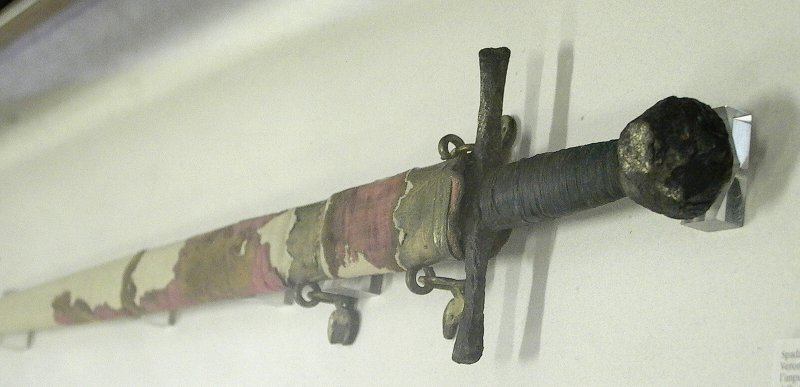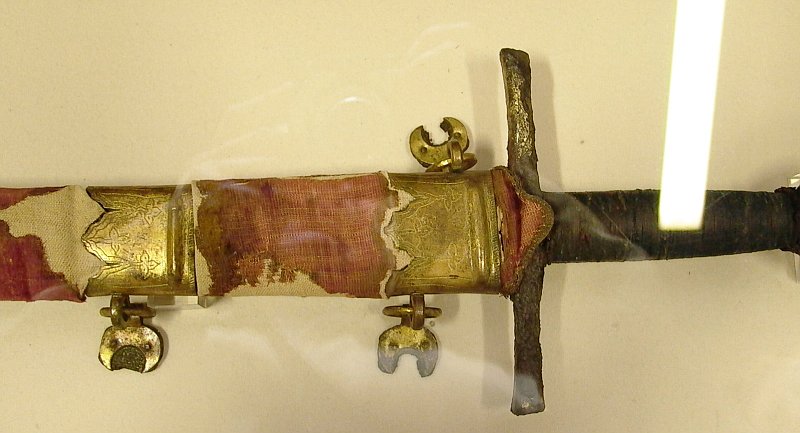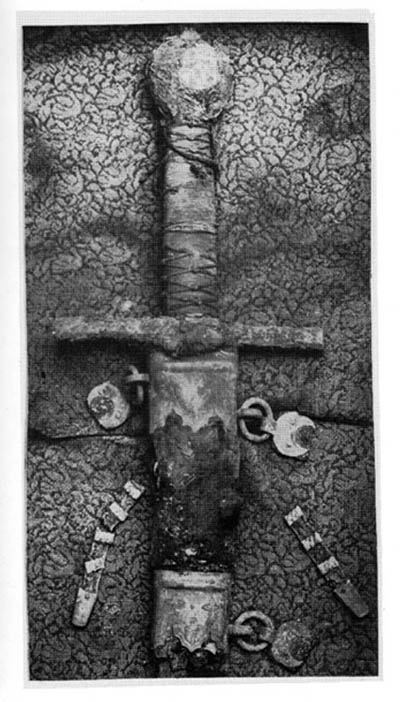
remains of the sword of Cangrande della Scala (from his grave)
 Attachment: 48.81 KB
Attachment: 48.81 KB


2nd
 Attachment: 65.58 KB
Attachment: 65.58 KB


3d
 Attachment: 72.19 KB
Attachment: 72.19 KB


Nice pics. When is the sword from. Is there any idea what type of blade it may have?
Thanks for posting those pix.
The pommel is interesting. In the first pic it looks like some kind of facted octagonal pommel, but in the last pic it looks like a "type-I" pommel.
He died in 1329, which would be most consistent with swords of type Xa, XII, XIV, and XVI. No way to tell without seeing the blade.
Brian M
The pommel is interesting. In the first pic it looks like some kind of facted octagonal pommel, but in the last pic it looks like a "type-I" pommel.
He died in 1329, which would be most consistent with swords of type Xa, XII, XIV, and XVI. No way to tell without seeing the blade.
Brian M
Great photos! Thanks for posting them! It's always wonderful to see new photos of these weapons, and being able to see them in color only deepens one's appreciation.
For what it's worth, in The Archaeology of Weapons Oakeshott identifies the blade as a type XII, though the weapon is only pictured sheathed (plate 17b) and the text is concerned primarily with the scabbard and its decoration.
For what it's worth, in The Archaeology of Weapons Oakeshott identifies the blade as a type XII, though the weapon is only pictured sheathed (plate 17b) and the text is concerned primarily with the scabbard and its decoration.
the blade was found, but it is exhibited in a sheated state.
This is just one of cangrande's swords, there was also a one and half sword and a stocco.
The red velvet is original, linen foundation is modern.
This is a serious archeological evaluation of his swords, including a quotation from Boccia (italian, sorry, no time for a translation)
http://www.spolia.it/online/it/argomenti/arch...grande.htm
this is what is said about the blade
"Pomo ottagonale rilevato a mozzo, con tracce di doratura a foglia; impugnatura leggermente a fuso, rivestita di fili di argento (in lega di rame) alternati a fili in seta, a intreccio. Crociera ingrossata in mezzeria, con tracce di capetta, e bracci brevi e diritti: il tutto originariamente dorato in foglia. Lama a doppio filo, scanalata al primo terzo e lievemente stondata in punta, largamente frammentata. Fodero originariamente in legno rivestito in pelle sottile e velluto rosso, largamente frammentario; meglio conservate la cappa, la ghiera e il puntale, in lega di rame sottilmente incisa a fogliettine e dorata per amalgama; campanelle di attacco a mezzaluna, due sulla cappa ed una sulla ghiera. Cintura in cuoio, blindata alle estreme, originariamente avvolta al fodero.
Most relevant from above
Octagonal pommel, traces of gilding (more evident to the eye than they are in the pics), handle coated with silver wires (oxidized) mixed with silk wires .... blade is double edged (doppio filo) fullered up to the first third of the blade (scanalata al primo terzo), slightly rounded at the point, the sword is largely fragmented (into pieces). Chape better preserved etc ...[/b]
This is just one of cangrande's swords, there was also a one and half sword and a stocco.
The red velvet is original, linen foundation is modern.
This is a serious archeological evaluation of his swords, including a quotation from Boccia (italian, sorry, no time for a translation)
http://www.spolia.it/online/it/argomenti/arch...grande.htm
this is what is said about the blade
"Pomo ottagonale rilevato a mozzo, con tracce di doratura a foglia; impugnatura leggermente a fuso, rivestita di fili di argento (in lega di rame) alternati a fili in seta, a intreccio. Crociera ingrossata in mezzeria, con tracce di capetta, e bracci brevi e diritti: il tutto originariamente dorato in foglia. Lama a doppio filo, scanalata al primo terzo e lievemente stondata in punta, largamente frammentata. Fodero originariamente in legno rivestito in pelle sottile e velluto rosso, largamente frammentario; meglio conservate la cappa, la ghiera e il puntale, in lega di rame sottilmente incisa a fogliettine e dorata per amalgama; campanelle di attacco a mezzaluna, due sulla cappa ed una sulla ghiera. Cintura in cuoio, blindata alle estreme, originariamente avvolta al fodero.
Most relevant from above
Octagonal pommel, traces of gilding (more evident to the eye than they are in the pics), handle coated with silver wires (oxidized) mixed with silk wires .... blade is double edged (doppio filo) fullered up to the first third of the blade (scanalata al primo terzo), slightly rounded at the point, the sword is largely fragmented (into pieces). Chape better preserved etc ...[/b]
Looking at the pictures I get the impression that there is linen covering the core. Does the archeologists' discussion say anything about cloth being glued over a wood core?
| Jared Smith wrote: |
| Looking at the pictures I get the impression that there is linen covering the core. Does the archeologists' discussion say anything about cloth being glued over a wood core? |
In Records of the Medieval Sword, Oakeshott notes the scabbard is red velvet over wood. It looks like the grip has lost most of the surviving green silk cord that was over the silver wire (see below)--though it was in pretty bad shape when Oakeshott documented it (apparently Can Grande's dead hand lay upon it from 1329-1921). Oakeshott also mentions that the upper and lower locket, chape and belt clasps are of silver, but they look gold in the pics. Were they guilded as well? It looks like the pattern on the scabbard furniture may have been punched or scratched through the gold to let the silver show through for contrast. Great pics! Thanks!

Thanks for the photos.
As I said, white foundation linen is modern (if seen with one's eyes, it is evident).
The italian text concurs obviously with Oakeshott sayng that the core is obviously wood.
But just a little chip of wood remains inside the chape.
White linen as a restoration is used to keep velvet into shape.
I see instead that on the handle the cross-like design has disappeard, the photo is relative to a first opening of the tomb in the twenties.
Now only the oxydized silver wire remains as wrapping .
The pic of the chape is poor, sorry but the sword is under glass and lightning was poor and mixed (neon + natural light), so long times and a just sufficient color rendition
 Attachment: 122.88 KB
Attachment: 122.88 KB
[ Download ]
The italian text concurs obviously with Oakeshott sayng that the core is obviously wood.
But just a little chip of wood remains inside the chape.
White linen as a restoration is used to keep velvet into shape.
I see instead that on the handle the cross-like design has disappeard, the photo is relative to a first opening of the tomb in the twenties.
Now only the oxydized silver wire remains as wrapping .
The pic of the chape is poor, sorry but the sword is under glass and lightning was poor and mixed (neon + natural light), so long times and a just sufficient color rendition
[ Download ]
Important: the italian text says that this is likely just a ceremonial sword, the characteristics of the handle and scabbard would suggest so.
Also the figure carved on the funeral marble stone carries a stocco, which is given as exposed at the same museum, where I couldn't see it, however.
Also the figure carved on the funeral marble stone carries a stocco, which is given as exposed at the same museum, where I couldn't see it, however.
Page 1 of 1
You cannot post new topics in this forumYou cannot reply to topics in this forum
You cannot edit your posts in this forum
You cannot delete your posts in this forum
You cannot vote in polls in this forum
You cannot attach files in this forum
You can download files in this forum
All contents © Copyright 2003-2006 myArmoury.com — All rights reserved
Discussion forums powered by phpBB © The phpBB Group
Switch to the Full-featured Version of the forum
Discussion forums powered by phpBB © The phpBB Group
Switch to the Full-featured Version of the forum